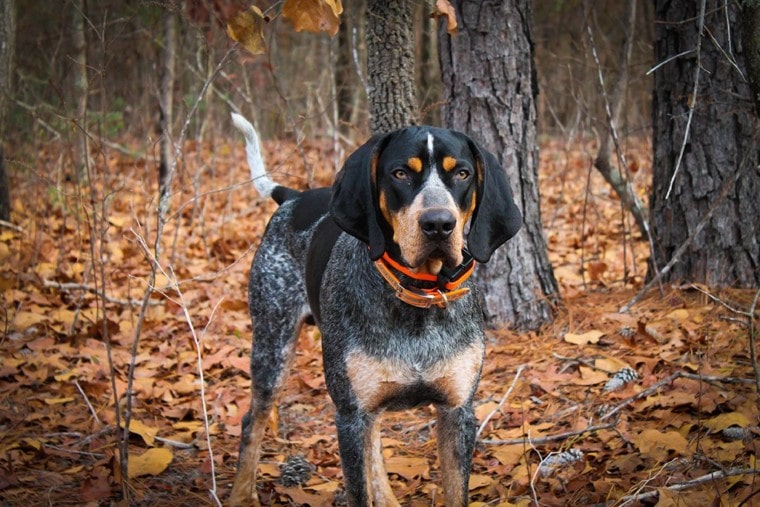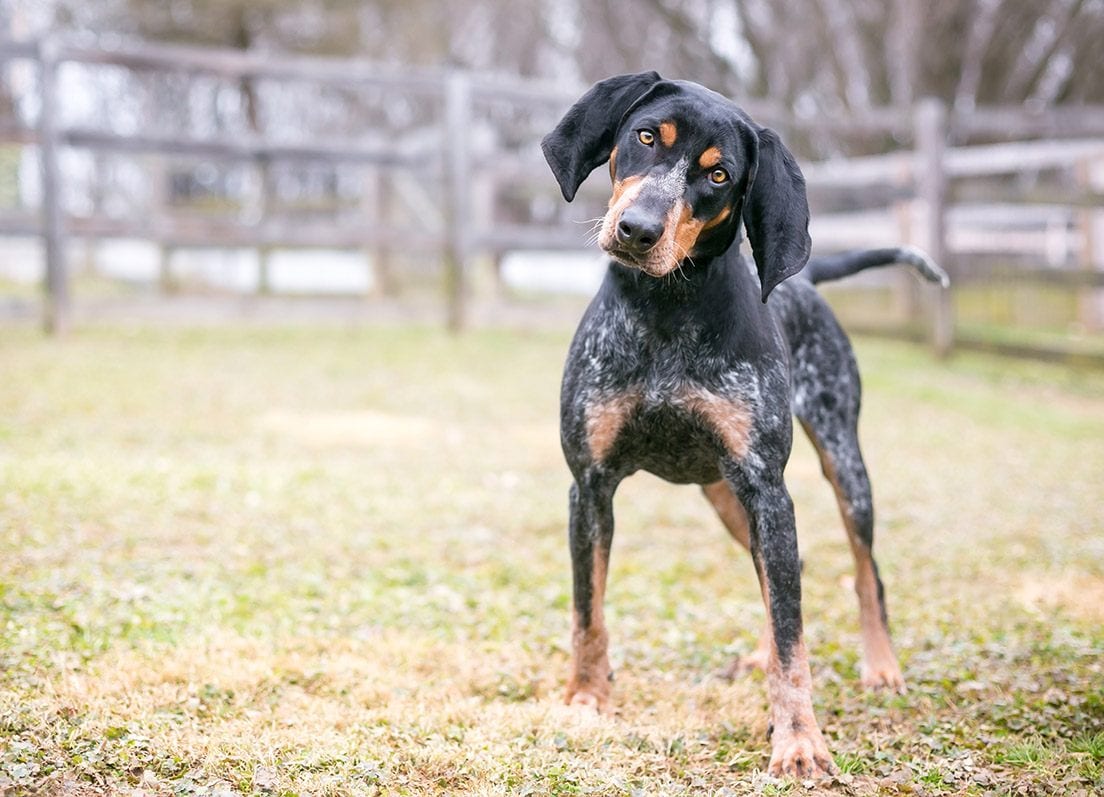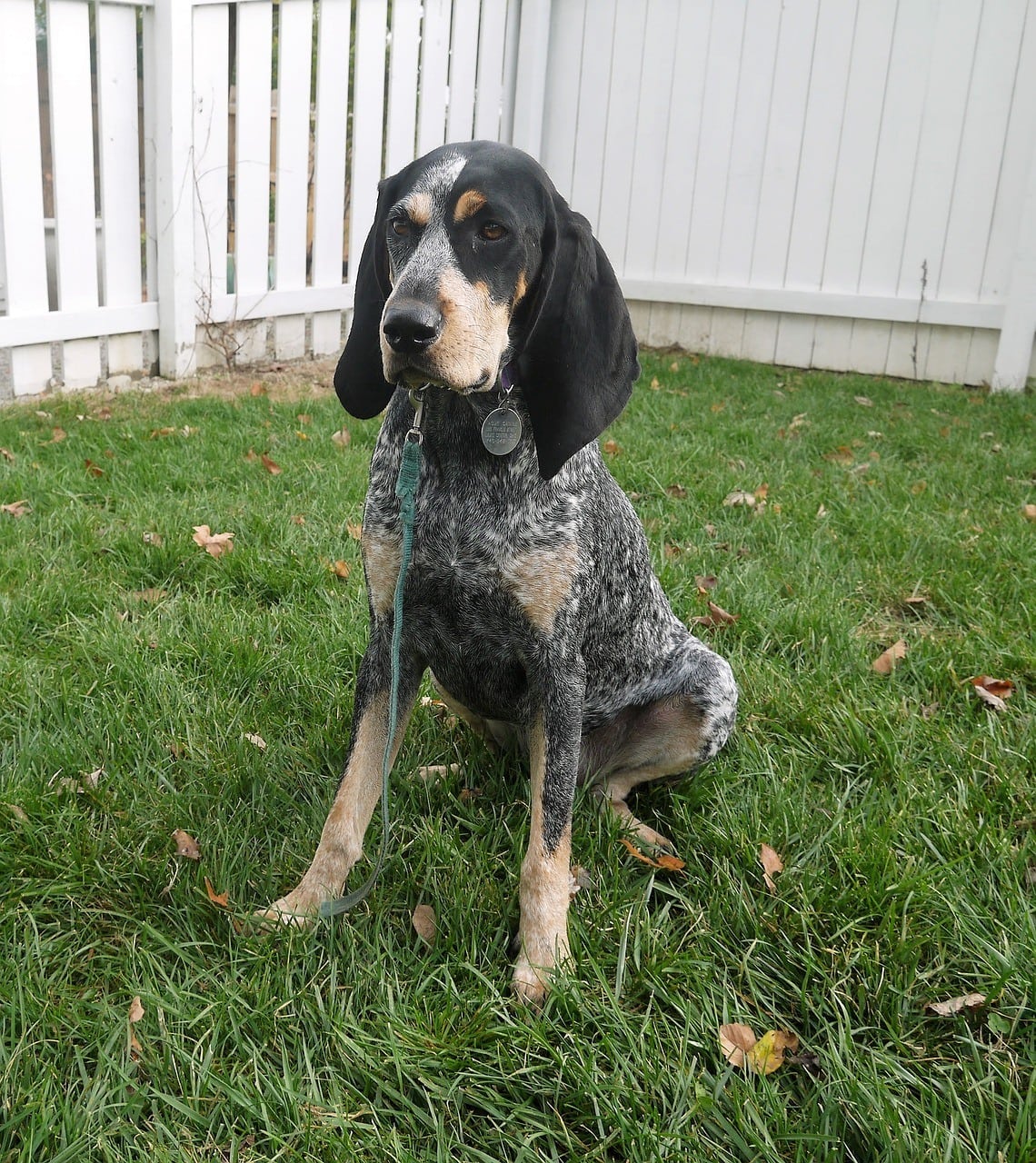
Click Below to Skip Ahead
The Bluetick Coonhound was developed in the United States for hunting purposes. These dogs are known for their friendly personality and unforgettable bluetick coat. They were originally bred for hunting raccoons. However, they are also regularly kept as companion animals. They are speedy and nocturnal hunters that thrive in the early morning hours.
Breed Overview
Height:
22 – 27 inches (male), 21 – 25 inches (female)
Weight:
55 – 80 pounds (male), 45 – 65 pounds (female)
Lifespan:
11 – 12 years
Colors:
Mottled blue
Suitable for:
Hunters, families without small pets
Temperament:
Relentless, smart, affectionate
Their chopping bark sounds similar to the bark of other hounds. They can be quite noisy, especially when they are pursuing their prey. Even Bluetick Coonhounds that are companion animals have an extremely high prey drive, which only makes them suitable for specific families.
Despite being bred for hunting, they are extremely affectionate and love their people. Their devoted nature makes them suitable for families with children of all ages. However, they require some sort of job to stay happy and entertained.
Bluetick Coonhound Characteristics
Bluetick Coonhound Puppies
These dogs are widely used throughout the United States for hunting purposes. For this reason, they are usually easy to find and can be inexpensive. That said, if you’re looking for a show dog or a dog that can hunt extremely well, expect to pay a bit more.
The Bluetick Coonhound is a friendly dog who is ideal as a hunting dog, but will make a good pet as well. They are extremely energetic so exercise is important if you are getting one as a pet. Training them will require a good amount of patience.
Temperament & Intelligence of the Bluetick Coonhound
The Bluetick Coonhound was bred to be a hunting dog, first and foremost. Many of their temperament traits are what make them good at hunting. However, not all these traits lead to a good companion animal.
They are hardy and athletic dogs. They thrive when given a job to do, like hunting. Companion Coonhounds will need a job even if they weren’t actually bred for hunting. Obedience and agility are good options for keeping these animals busy.
Their stubbornness and high energy needs often make them difficult to train. They don’t necessarily pay attention as well as they should during training times and might not respond to a command even if they know it. They are relatively intelligent, but more so in the problem-solving realm than during training time.
This breed is extremely vocal, so be prepared. There isn’t much you can do about their loud voice due to their stubbornness and innate need to bay. Training often doesn’t do much to tone down the noise level. They are sometimes mistaken as aggressive breeds, as they tend to bay at strangers in greeting. Sometimes, this can be mistaken for a growl or aggressive bark, though it is just how they sound.
Their nose can get them in trouble. They will follow it into the garbage or onto the counters if left unsupervised. They love tracking down just about anything smelly.
Are These Dogs Good for Families? 👪
When socialized properly, they can be good family dogs. They are often gentle with children. Their larger size means that they are too big for most children to injure or scare, which prevents fear-driven aggression. They also aren’t rambunctious enough to knock children down most of the time, especially if their exercise needs are met.
Due to their highly athletic nature, they do need quite a bit of exercise and training You should expect to spend at least 1-2 hours a day educating these canines.
Does This Breed Get Along With Other Pets?
These dogs often get along just fine with other dogs. Early socialization is still important, but these dogs aren’t particularly aggressive toward other canines, especially those of their size or bigger. They are generally pack animals and enjoy the company of other dogs, especially if they make good playmates. Some breeders may even recommend that you adopt two dogs, as one may get bored if left alone.
However, this breed is not suitable for homes with cats, small pets, or even smaller dogs. These animals will likely be seen as prey and chased. Socialization can help, but we still do not recommend leaving these dogs unsupervised with any animal that is much smaller than them. Their chase and tracking instincts are undeniable, which can lead to them chasing and potentially killing cats, even ones that they have known for years.
Things to Know When Owning a Bluetick Coonhound
Food & Diet Requirements 🦴
The Bluetick Coonhound does not have any particular nutritional needs. A high-protein diet with plenty of meat is best. Look for formulas that are designed for highly active dogs, as the Bluetick falls into this category.
These dogs are food-driven and will often steal food if they can find it. As they are also good at problem-solving, it is important to keep everything locked up tight. This will not only prevent them from eating too many calories, but it can also keep them safe from harmful foods, like grapes and nuts.
If not exercised properly, these dogs can be prone to obesity. They may also eat too much if left to their own devices. Food consumption should be carefully monitored to ensure that your canine stays at a healthy weight. Like all dogs, obesity can affect their joints and cause further health problems.

Exercise 🐕
As active dogs, the Bluetick Coonhound is quite energetic and needs regular, frequent exercise. Plan on spending at least an hour or so exercising your dog each day. This can be done by long walks on a leash or an intense play session. Their prey drive means that fetch is an instant hit. They are often good at agility and tracking, which can be a useful way to wear them out without wearing you out too much.
When these dogs aren’t exercising, they can actually be quite lazy. Their energy levels are either all the way on or completely off. Expect to find them napping throughout much of the day, only to run around the backyard after their energizing nap.
Training 🎾
These dogs are often described as smart. However, their intelligence focuses more on problem-solving, which doesn’t apply to most training. They can also be quite stubborn. They may learn the commands after a few sessions, but that doesn’t necessarily mean they’ll always listen to you.
They are often treat-driven. You can use this to your advantage during training, but expect to carry around treats whenever you need your dog to reliably listen to you. Otherwise, they may ignore you.
Luckily, these dogs are fairly well-behaved indoors. Their recall is unreliable, however, even if they are well trained. When they pick up on a trail, they stop listening to everything else. For this reason, we do not recommend letting them off-leash unless they’re in a secure area.
Grooming ✂️
The Bluetick Coonhound is easy when it comes to grooming. They have a short coat that sheds moderately. A quick weekly brushing will help remove excess hair and prevent much of it from ending up on your furniture. They often don’t require baths, unless they get into something that is especially messy.
Their nails should be trimmed often. They seem to grow quite fast, even if the dog is regularly exercised. Long nails can cause the dog pain, especially when running. Because this breed is so active, it can be particularly problematic. Their ears need to be cleaned and looked after as well. Dirt and debris can become stuck inside. A wet cotton ball can easily remove dirt that happens to get lodged.
Their teeth need to be brushed regularly as well, which is essential to maintain proper dental health.

Health and Conditions 🏥
These dogs are quite healthy, mostly because they have been bred for practical reasons. Many are bred for hunting in particular, which requires that they have an efficient body and minimal health problems. However, they can still get a few issues.
These deep-chested dogs may be prone to bloat, which is a serious condition involving the stomach. When a dog has bloat, their stomach expands with gas that cannot be expelled for one reason or another. Sometimes the stomach twists but this isn’t always the case. The expanded stomach will block off blood flow from the surrounding tissue, which can kill the dog rather quickly. It is important to see an emergency vet as quickly as possible if this happens, as this is a life-threatening condition that progresses quickly.
These dogs may also be prone to hip dysplasia. This is due to their weight and high energy level. They can wear down their joints rather easily, which can cause significant hip problems and arthritis. You should feed them carefully in their puppy years, as too many calories can lead to faster growth than the bones and joints can accommodate.
Male vs. Female
Male dogs are often significantly larger than the females. Besides this, there is no other significant difference between the two sexes.
3 Little-Known Facts About the Bluetick Coonhound
1. They can detect “cold” trails.
This canine can detect old trails that have been around for some time. This is one reason that they make such good hunters. However, this also means that they can find a trail in just about any wooded area, which can be a problem for owners who are just trying to take a walk.
2. The Bluetick Coonhound was developed in America.
This hunting dog was bred in America starting in the colonial days. They are the result of interbreeding the French Grand Bleu de Gascogne and the English Foxhound, which were brought over with the colonists.
3. They can get big.
These dogs are on the larger side of the hound spectrum. Males can get up to 80 pounds.
Final Thoughts
Bluetick Coonhounds make great hunting dogs. They can also make suitable companion dogs in certain situations. They require a rather active family. They were bred to hunt daily and need to expend a similar amount of energy when kept as pets. They are friendly and affectionate, though, which allows them to fit in with most families.
They are relatively healthy and don’t require much grooming. Apart from the occasional brushing session to remove excess hair, they don’t require much else. This allows you to spend plenty of time on their energy needs. They can be quite stubborn when it comes to training, but this is common for most hounds.
Featured Image Credit: Taylor Walter, Shutterstock








